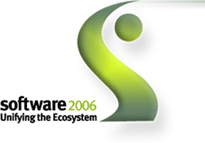
Software 2006 hasn’t even started yet, but I already like it. Software Connections powered by BDMetrics is a cool web-based service that allows you to optimize your participation at the two-day conference.
After creating a profile, Connections will make personalized recommendations for your event plan, companies to see, people to meet. Of course it’s not just a recommendation system, you can actively serach for all the above, propose meetings with other attendees while preserving their privacy.
If you ever wondered around an expo floor with a list of people you want to meet, yet have no way of finding them, you’ll appreciate this service – especially if there will be workstations throughout the conference site to access the system. The one item I’d like to see added: mobile alerts on networking requests or responses to one’s own requests.
Tags: Software2006, Software Connections, BDMetrics, Conference Efficiency, Event Networking



 1.) Take a good old business model, in this case
1.) Take a good old business model, in this case  user interface.
user interface.
 (Updated)
(Updated)

 – otherwise a digg-like voting system would make more sense.
– otherwise a digg-like voting system would make more sense. the open community at large, too.
the open community at large, too.
Recent Comments